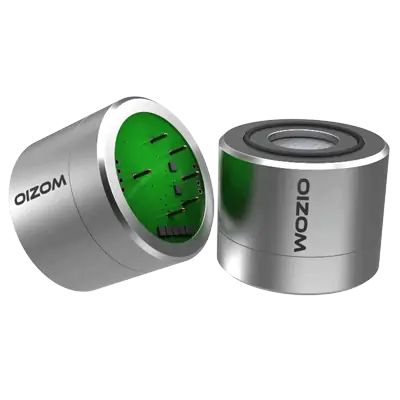
BTEX Sensor
Real-Time BTEX Monitoring for Safer Industrial Environments
BTEX (Benzene, Toluene, Ethylbenzene, and Xylene) compounds are toxic volatile organic compounds (VOCs) commonly found in industrial emissions, fuel vapors, and vehicular exhaust. OZBTEX_1 offers precise, real-time detection of BTEX and other critical VOCs. Designed for real-time ambient air quality monitoring, this compact sensor ensures high sensitivity and reliability in diverse environments, from industrial zones to urban settings.
The sensor uses photoionization detection (PID), where a 9.8 eV ultraviolet (UV) lamp ionizes volatile organic compounds (VOCs) like BTEX. The ionized molecules generate a measurable electric current, which is directly proportional to the concentration of the target gases, enabling accurate and real-time detection.
This sensor module is designed with advanced support electronics that enhance its compactness and reliability. Its low-noise electronics ensure stable and precise detection of BTEX (Benzene, Toluene, Ethylbenzene, and Xylene). It’s engineered to perform reliably in extreme outdoor and industrial environments, with an operating range of -20°C to +50°C and up to 99% non-condensing humidity. Its modular design makes it easy to integrate into fixed or portable air monitoring systems, allowing seamless deployment across varied applications.
The sensor is lab-calibrated using isobutylene as a reference gas, ensuring accurate baseline readings from day one. For long-term performance, it supports manual field calibration with certified gas standards. This helps correct for environmental drift or site-specific VOC mixtures. Periodic recalibration maintains measurement accuracy, especially in high-exposure or variable conditions.
Working Principle: Photoionization (PID) with 9.8 eV UV lamp
Detection Range: 0-10 ppm (for isobutylene)
Resolution: 0.001 ppm
Operating Temperature: -20°C to +50°C
Humidity Range: 0–99% RH (non-condensing)
Oil & Gas Refineries
BTEX compounds are common byproducts in refining processes. Continuous monitoring helps detect leaks early, reduce worker exposure, and stay compliant with environmental regulations.
Hazardous Waste Sites
Decomposing industrial waste often releases BTEX gases. Real-time monitoring prevents health risks for cleanup crews and nearby communities.
Paint and Coating Industries
Solvent use in production can emit BTEX. Monitoring these emissions protects workers and helps control indoor air quality.
Urban Air Quality Monitoring
Traffic and fuel evaporation contribute to BTEX pollution. Cities can track ambient levels to identify hotspots and shape clean air policies.
Automotive Workshops
Paints, fuels, and cleaners release BTEX. Sensors can be used to maintain air quality and protect workers from long-term exposure.
Environmental Impact Studies
Researchers and agencies use BTEX data to assess pollution from industrial sites, traffic, or accidental spills, helping shape environmental policy and remediation plans.
Looking for Air Quality Monitoring Solution for your Project?
Schedule a call with our team of experts and get a customised solution for your air quality monitoring requirement.
Frequently Asked Questions (FAQs)
BTEX stands for Benzene, Toluene, Ethylbenzene, and Xylene, common volatile organic compounds found in industrial emissions and fuels.
These compounds are toxic and harmful to human health. Monitoring helps detect exposure early and ensures compliance with safety regulations.
It uses a photoionization detector (PID) that ionizes VOCs with UV light and measures the resulting electric signal.
It delivers 90% of the reading in less than 2 minutes, making it ideal for real-time monitoring.
Oizom’s sensor combines high sensitivity with rugged design. It delivers real-time data, is easy to integrate, and works reliably in extreme outdoor conditions, ideal for both industrial and ambient monitoring.
Yes, it’s built with a durable body and works well in extreme temperatures and high humidity.
The sensor is enclosed in a weather-resistant stainless steel housing. While it’s designed for outdoor use, proper housing or enclosures are recommended for long-term exposure to rain or direct splash.


